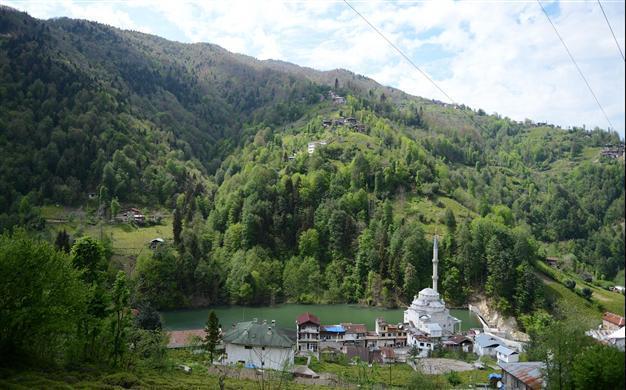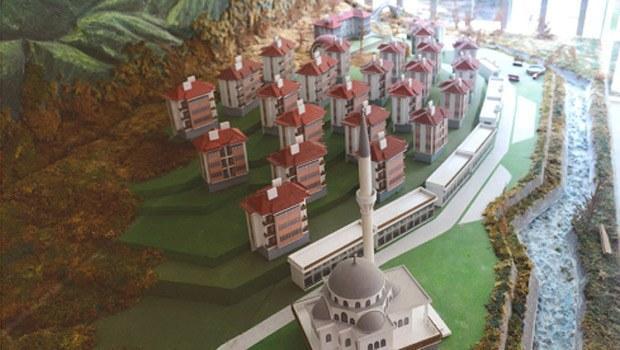Resistance to urban renewal in historic Black Sea town
HÜRRİYET / HEMŞİN

The Hemşin people, or Hemşinites, were originally Armenians who fled to the Pontus region along the eastern Black Sea as Arab troops occupied their homeland in 790. Levent KULU
Although Turkey’s Council of State granted a stay of execution on a controversial urban renewal project, the Prime Ministry’s Housing Development Administration (TOKİ) has geared up to partly demolish a sleepy Black Sea town which was home to Armenians in the past, triggering local resistance.Hemşin lies next to its touristic neighbor Çamlıhemşin in the eastern Black Sea province of Rize. Tea growing is the primary source of income for the 2,300 people living in the town.
Former mayor Başar Cumbur was the first official to come up with the urban renewal idea in the area in 2006. “Our goal was to protect the historical structures, while renovating the bad ones. We wanted to create a Hemşin town where people could stay permanently,” Cumbur said.
He therefore signed a protocol with TOKİ in 2008, but locals opposed the municipality’s initial plans. As a result, the mayor changed and so did the plans. Now, TOKİ plans to turn Hemşin into a touristic town with 157 residences and 29 shops. Each apartment will cost approximately 150,000 Turkish Liras (50,780 euros).

Three citizens sued TOKİ and the Hemşin Municipality at the Rize Regional Administrative Court in 2010, claiming that their rights were violated. The court then ordered a stay of execution and canceled the project. However, the Council of Ministers upped the ante in 2011 by permitting all Hemşin to be declared as an urban renewal area, where every building within 7 hectares would be demolished.
Locals sued the project at the Council of State this time, referring to the earlier ruling of the regional court. While the Council of State ordered its experts to prepare a report on the project, the government made another preemptive move and declared an “urgent expropriation” of the project area in Hemşin, using a law that lets the state expropriate private property in times of war.
Ali Bayraktar, a shop owner in Hemşin who is closely following the court cases about the town, argues that it is illegal for the government to use a law about national defense for urban renewals. The Council of State issued another stay of execution when locals challenged the government again.
Rejecting the objections of the Prime Ministry, the Interior Ministry and the Hemşin Municipality, the Council of State also sent three professors to the town from Dokuz Eylül University in 2013. Their 60-page report ruled that Hemşin was not suitable for urban renewal due to its historical and geographical structure.
Although the high court has yet to issue a final verdict, TOKİ scheduled a tender on Hemşin Urban Renewal Project for May 20, ignoring the earlier rulings and local resistance.
Nobody knows what will happen next, as only two schools, a forestry office, the provincial governor’s office and municipality housings have been demolished for now. The construction of a public park is ongoing, but locals ridicule it, too, stressing the town already lies in a naturally beautiful, historically rich area near the Black Sea.
The Hemşin people, or Hemşinites, were originally Armenians who fled to the Pontus region along the eastern Black Sea as Arab troops occupied their homeland in 790. In 1480 the Ottomans conquered the area and in 1600 instituted the “devşirme” system, in which suitable young boys were taken from Christian families to be educated and often converted to Islam to get rid of special taxes that were applied to them. Some of the Hemşin now live in Armenia, where they have settled and have even opened a newspaper called Hemşin Hay (Hemşin Armenians).
İsmet Şahin, a politician who is a prominent member of the Hemşin community, told the Hürriyet Daily News in 2011 that modern day Hemşin identify themselves neither as Armenians nor Turks.
“In recent years, more and more people have begun claiming they are discovering their Armenian identity, and I do not find this sincere. Hemşinites have always identified themselves as Hemşinites. If you ask whether they are Turks, you would elicit a negative response. If you ask whether they are Armenians, again you would elicit a negative response. They would only tell you they are Hemşinites,” said Şahin.
Today, locals are not dead set against urban renewal, but they claim their rights and want their cultural assets be preserved.
Zekeriya Birlik, the baker of the town, opposed the demolition of his shop built in 1928. “We could restore the buildings. Do they really have to demolish them?” he asked.
Emine Kobal, 70, said she has been living in Hemşin since she was born. She has the means to sell her land and buy a new apartment that the government intends to build here, but she resists.
“I have lived here for 32 years with my husband. Now I live with his memory. They told me to sell my land and go away. My heart is here, I’m happy here and I need to see my garden and eat from its crops,” Kobal says.
















